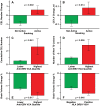Environmental factors associated with disease progression after the first demyelinating event: results from the multi-center SET study
- PMID: 23320113
- PMCID: PMC3540021
- DOI: 10.1371/journal.pone.0053996
Environmental factors associated with disease progression after the first demyelinating event: results from the multi-center SET study
Abstract
Objectives: To investigate the associations of environmental MS risk factors with clinical and MRI measures of progression in high-risk clinically isolated syndromes (CIS) after the first demyelinating event.
Methods: We analyzed 211 CIS patients (age: 28.9±7.8 years) enrolled in the SET study, a multi-center study of high-risk CIS patients. Pre-treatment samples were analyzed for IgG antibodies against cytomegalovirus (anti-CMV), Epstein Barr virus (EBV) early nuclear antigen-1 (EBNA-1), viral capsid antigen (VCA), early antigen-diffuse (EA-D), 25 hydroxy-vitamin D3 and cotinine levels and HLA DRB1*1501 status. The inclusion criteria required evaluation within 4 months of the initial demyelinating event, 2 or more brain MRI lesions and the presence of two or more oligoclonal bands in cerebrospinal fluid. All patients were treated with interferon-beta. Clinical and MRI assessments were obtained at baseline, 6, 12, and 24 months.
Results: The time to first relapse decreased and the number of relapses increased with anti-CMV IgG positivity. Smoking was associated with increased number and volume of contrast-enhancing lesions (CEL) during the 2-year period. The cumulative number of CEL and T2 lesions during the 2-year period was greater for individuals in the highest quartile of anti-EBV VCA IgG antibodies. The percent loss of brain volume was increased for those in the highest quartile of with anti-EBV VCA IgG antibodies.
Conclusions: Relapses in CIS patients were associated with CMV positivity whereas anti-EBV VCA positivity was associated with progression on MRI measures, including accumulation of CEL and T2 lesions and development of brain atrophy.
Conflict of interest statement
Figures


Similar articles
-
Humoral responses to herpesviruses are associated with neurodegeneration after a demyelinating event: results from the multi-center set study.J Neuroimmunol. 2014 Aug 15;273(1-2):58-64. doi: 10.1016/j.jneuroim.2014.04.012. Epub 2014 Apr 30. J Neuroimmunol. 2014. PMID: 24907902
-
Interactions of serum cholesterol with anti-herpesvirus responses affect disease progression in clinically isolated syndromes.J Neuroimmunol. 2013 Oct 15;263(1-2):121-7. doi: 10.1016/j.jneuroim.2013.07.010. Epub 2013 Aug 2. J Neuroimmunol. 2013. PMID: 23916695
-
Humoral response to Epstein-Barr virus in patients with multiple sclerosis treated with B cell depletion therapy.Mult Scler Relat Disord. 2023 Nov;79:105037. doi: 10.1016/j.msard.2023.105037. Epub 2023 Sep 30. Mult Scler Relat Disord. 2023. PMID: 37804765 Clinical Trial.
-
Serological Evidence for the Association Between Epstein-Barr Virus Infection and Sjögren's Syndrome.Front Immunol. 2020 Oct 30;11:590444. doi: 10.3389/fimmu.2020.590444. eCollection 2020. Front Immunol. 2020. PMID: 33193425 Free PMC article.
-
Environmental factors and risk of multiple sclerosis: Findings from meta-analyses and Mendelian randomization studies.Mult Scler. 2020 Apr;26(4):397-404. doi: 10.1177/1352458519872664. Epub 2019 Sep 6. Mult Scler. 2020. PMID: 32249718 Review.
Cited by
-
Smokers with MS have greater decrements in quality of life and disability than non-smokers.Mult Scler. 2017 Nov;23(13):1772-1781. doi: 10.1177/1352458516685169. Epub 2017 Jan 6. Mult Scler. 2017. PMID: 28059618 Free PMC article.
-
Serum lipid profile changes predict neurodegeneration in interferon-β1a-treated multiple sclerosis patients.J Lipid Res. 2017 Feb;58(2):403-411. doi: 10.1194/jlr.M072751. Epub 2016 Dec 6. J Lipid Res. 2017. PMID: 27923871 Free PMC article.
-
The role of Epstein-Barr virus in multiple sclerosis: from molecular pathophysiology to in vivo imaging.Neural Regen Res. 2019 Mar;14(3):373-386. doi: 10.4103/1673-5374.245462. Neural Regen Res. 2019. PMID: 30539801 Free PMC article. Review.
-
Smoking at time of CIS increases the risk of clinically definite multiple sclerosis.J Neurol. 2018 May;265(5):1010-1015. doi: 10.1007/s00415-018-8780-4. Epub 2018 Feb 20. J Neurol. 2018. PMID: 29464378 Free PMC article.
-
Longitudinal MRI and neuropsychological assessment of patients with clinically isolated syndrome.J Neurol. 2014 Sep;261(9):1735-44. doi: 10.1007/s00415-014-7413-9. Epub 2014 Jun 22. J Neurol. 2014. PMID: 24952618
References
-
- Ascherio A, Munger KL (2007) Environmental risk factors for multiple sclerosis. Part II: Noninfectious factors. Ann Neurol 61: 504–513. - PubMed
-
- Ascherio A, Munger KL (2007) Environmental risk factors for multiple sclerosis. Part I: the role of infection. Ann Neurol 61: 288–299. - PubMed
-
- Zivadinov R, Weinstock-Guttman B, Zorzon M, Uxa L, Serafin M, et al. (2009) Gene-environment interactions between HLA B7/A2, EBV antibodies are associated with MRI injury in multiple sclerosis. J Neuroimmunol 209: 123–130. - PubMed
Publication types
MeSH terms
Substances
LinkOut - more resources
Full Text Sources
Other Literature Sources
Medical
Research Materials

